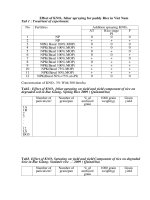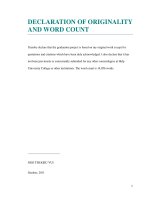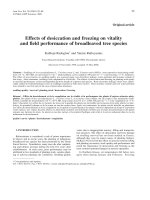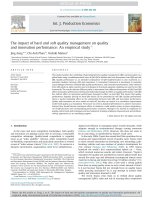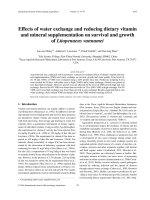Evaluation of IBA labels on vegetative and rooting performance of dormant cuttings of plum cv Santa rosa under mist
Bạn đang xem bản rút gọn của tài liệu. Xem và tải ngay bản đầy đủ của tài liệu tại đây (199.55 KB, 5 trang )
Int.J.Curr.Microbiol.App.Sci (2019) 8(10): 693-697
International Journal of Current Microbiology and Applied Sciences
ISSN: 2319-7706 Volume 8 Number 10 (2019)
Journal homepage:
Original Research Article
/>
Evaluation of IBA Labels on Vegetative and Rooting Performance of
Dormant Cuttings of Plum Cv Santa Rosa under Mist
Amit Kotiyal1* and Anant Ram Nautiyal2
1
2
Department of Horticulture, HNBGU, Srinagar Garhwal-246174, Uttarakhand, India
High Altitude Plant Physiology Research Centre (HAPPRC), HNBGU, Srinagar Garhwal246174, Uttarakhand, India
*Corresponding author
ABSTRACT
Keywords
Indole 3-butyric
acid (IBA), Santa
Rosa plum, Cuttings
Article Info
Accepted:
07 September 2019
Available Online:
10 October 2019
Commercially plum is multiplied by budding and grafting which is a
difficult exercise for unskilled farmers. Therefore, multiplication through
semi hard wood stem cuttings in mist house has been studied with six
treatments of indole-3-butyric acid concentrations (0, 1000, 1500, 2000,
2500 and 3000 ppm) at Horticulture Research Center, HNBGU, Srinagar
Garhwal, Uttarakhand during the year 2016-17 under Ph.D. discipline.
Cuttings were treated by quick dip (2 minute) method and planted in
disposable glass. All observations were registered after 90 days of planting
the cuttings under mist chamber. Among all the IBA treatments, cuttings
treated with 1000 ppm IBA concentration resulted significantly highest in
respect of fresh weight of shoot (0.26g), dry weight of shoot (0.099g),
rooting percentage (71.67%), fresh weight of root (0.123g) and dry weight
of root (0.028g) followed by 1500 ppm IBA treatment. The pattern of root
and shoot growth indicated that their growth is affected by IBA level as
well as by the growth of each other.
Introduction
Plums are one of the widely cultivated stone
fruits and characterized as a firm flesh with
sweet, sour, juicy and delicious flavour fruit.
They can be consumed fresh but are
commonly processed, mostly into prunes or
distilled drinks (Catherine and Ginies, 2009).
Japanese plums are well adapted in the hills of
northern states of India. Among different
cultivars Santa Rosa is delicious fruit cultivar
of Japanese plum. It requires 400-700 hrs of
chilling temperature. Multiplication of these
progeny for Propagation is important aspect in
fruit cultivation because it is required for
multiplication of progeny of same cultivar.
Commercially plum is propagated by budding
and grafting which requires high skilled man
693
Int.J.Curr.Microbiol.App.Sci (2019) 8(10): 693-697
power where as rate of success is very less
(Ananda 1993). Besides this the availability
and selection of corret scion and rootstock
makes it bottle neck of propagation. Stem
cutting is the simplest method of propagation
which needs very less care and skill, and helps
for shallow rooted plant which causes
dwarfing effect and makes it suitable for high
density plantation. But some woody plants
have limitation in regeneration of rooting
through cuttings. There are several factors
known which affect rooting in woody species
such as wounding of cuttings, air environment,
substrate, genotype, season and plant growth
regulators. Among all these factors auxins
play important role in rooting regeneration of
stem cutting of fruit plants (Canli and Bozkurt,
2009). In a study Narula (2018) reported that
stem cuttings of Kala Amritsari plum
regenerate maximum shoot and root growth in
2000 ppm IBA treatment among all of the IBA
treatments. In temperate region Santa Rosa
plants grow very well but are found less
successful in juvenile stage due to frost injury.
So these plants may be grown under mist in
subtropical
and
temperate
condition.
Therefore, keeping the above factors in view,
the present study has been planned to check
the performance of auxin concentration levels
in plum cuttings for having true plant
progenies.
Materials and Methods
The present investigation has been carried out
in the Horticultural Research Centre, and
Department of Horticulture, H.N.B. Garhwal
University, Srinagar (Garhwal), Uttarakhand,
during the year 2016-17. Santa Rosa plum
cuttings were prepared of 16 cm length and
0.4 to 0.6 mm diameter from more than 10
year old trees of Santa Rosa plum established
at Horticultural Research Centre, Chauras
Srinagar Garhwal. Prepared cuttings were
treated with six IBA concentrations (0, 1000,
1500, 2000, 2500 and 3000 ppm) and planted
on 1st December under the mist chamber. The
cuttings were planted in disposable glass of
200 gm capacity filled with (Coco peat, Vermi
compost, sand and soil @ 2:2:1:1 portion)
rooting media. An intermittent mist system
was set at 22±2 0C temperature and 79-85 %
relative humidity and mist were relayed at 30
minute interval for 20 second. The experiment
was organized according to randomized block
design (RBD). All observations of cuttings
were recorded after 90 days of planting the
cuttings under mist of each treatment.
Results and Discussion
In the present study, different IBA
concentrations in term of fresh and dry weight
of shoot, rooting percentage, fresh and dry
weight of root has been noticed significantly
which are presented in Table 1 with the mean
values of the observations.
Fresh and dry weight of shoot
The analyzed data reveals that fresh and dry
weight of shoot in Santa Rosa plum cutting
under mist condition has significantly been
influenced by auxin concentration level. The
maximum fresh weight of shoot (0.26 g) was
observed in 1000 ppm IBA followed by 1500
ppm (0.25 g), 2000 ppm (0.23 g) while
minimum was in 3000 ppm (0.13 g) followed
by 2500 ppm (0.20g) and control (0.21 g). Dry
weight of shoot was recorded maximum in
1000 ppm IBA (0.099 g) followed by 1500
ppm (0.096 g), control (0.089 g) and minimum
in 3000 ppm (0.038 g) followed by 2500 ppm
(0.083 g) and 2000 ppm (0.088 g).
Growth in weight may probably be due to
increased number of leaves and girth of shoot
which could have resulted in more amount of
dry matter accumulation as a consequence of
higher amount of photosynthesis. Similar
findings were observed by Jana et al. (2015)
who reported maximum 75.40 g fresh weight
694
Int.J.Curr.Microbiol.App.Sci (2019) 8(10): 693-697
of shoot in Asian pear cutting with 1000 ppm
IBA concentration followed by 500 ppm and
1500 ppm, while the minimum was in control.
In another study, Rajeshwari et al. (2015)
reported the maximum 9.64 g fresh weight and
6.41 g dry weight of shoot in drumstick
cuttings in 1500 ppm concentration among
four treatments (0, 500, 1000 and 1500 ppm
IBA) of IBA.
Rooting percentage
Rooting percentage has been found
significantly maximum in 1000 ppm (71.67%)
followed by 1500 ppm (68.33%), 2000 ppm
(63.33%) and minimum rooting percentage
was in 3000 ppm IBA (28.33%) followed by
2500 ppm (55%) and control (60%). However,
in relation to the present findings, Jana et al.
(2015) and Ibrahim et al. (2015) found that
among different IBA concentrations, 1500
ppm was highest in rooting percentage
followed by 2000 ppm and 2500 ppm while
the minimum was in control of lemon verbena
cuttings. Canli and Bozkurt (2009) also
noticed that 1500 ppm had best (87.5%)
rooting percentage followed by 2000 ppm
(75.0%) of IBA treatment in semi hardwood
cutting of ‘Sarierik’ plum. The rooting
percentage decreased with the increasing
concentration of IBA beyond an optimal level
probably due to its inhibitory effect at higher
concentration. The increase in rooting
percentage may possibly be attributed to
division of the root initial cells, which are
dependent either upon applied or endogenous
auxin content.
Table.1 Effect of IBA level on fresh and dry weight of shoot, rooting percentage and fresh and
dry weight of root of Santa Rosa plum cuttings under mist environment
Treatments
Control (0 ppm)
1000 ppm
1500 ppm
2000 ppm
2500 ppm
3000 ppm
CD (5 %)
SEm±
Fresh weight
of shoot (g)
0.21
0.26
0.25
0.23
0.20
0.13
0.06
0.02
Dry weight of
shoot (g)
0.089
0.099
0.096
0.088
0.083
0.038
0.026
0.008
Rooting
%
60.00
71.67
68.33
63.33
55.00
28.33
13.96
4.43
Fresh weight
of root (g)
0.029
0.123
0.057
0.053
0.025
0.018
0.022
0.007
Dry weight
of root (g)
0.009
0.028
0.014
0.014
0.008
0.004
0.007
0.002
Fig.1 Rooting in different IBA concentrations of 1st December planted cuttings
695
Int.J.Curr.Microbiol.App.Sci (2019) 8(10): 693-697
Fig.2 Root and Shoot growth of Santa Rosa plum cuttings under different IBA levels in mist
environment
Fresh and dry weight of root
In fresh weight of root 1000 ppm accounted
maximum weight (0.123g) followed by 1500
ppm (0.057g), 2000 ppm (0.053g) where as
minimum fresh weight of root was in 3000
ppm (0.018g) followed by 2500 ppm (0.025g)
and control (0.029g). Dry weight of root was
maximum in 1000 ppm (0.028g) followed by
1500 ppm (0.014g), 2000 ppm (0.014g) where
as minimum dry weight of root was in 3000
ppm (0.004g) followed by 2500 ppm (0.008g)
and control (0.009g). Similar findings were
observed by Jana et al. (2015) who reported
that 1000 ppm had maximum (17.31 g) root
weight followed by 500 ppm, and the
minimum was in control. However,
Rajeshwari et al. (2015) observed in their
findings that 1500 ppm IBA treatment
increased root fresh and dry weight of
drumstick cuttings along with coco-peat as
media. Galavi et al. (2013) noticed that among
four IBA treatments (0, 2000, 4000, 6000
mg/L) in grape cutting, 4000 mg/L contained
highest (0.1125 g) dry weight of root followed
by 2000 mg/L (0.0985 g), while the minimum
(0.0685 g) was in 8000 mg/L.
More fresh as well as dry weight of root may
be due to factors leading to better
development of roots including the influence
of IBA which helps in promoting root
formation.
A trend was noticed in the growth of shoot
and roots of Santa Rosa plum cuttings after
being treated with different IBA levels and it
was found that the cuttings increased in
rooting growth and at the same time increment
in shoot growth was also observed (Fig.2).
This indicates that the proportion of shoots
and roots growth increases together and are
influenced by the growth of each other.
Hence on the basis of above investigation it
may be concluded that among all IBA levels
1000 ppm concentration is the best treatment
with respect to rooting and vegetative growth
of Santa Rosa plum cutting. Therefore,
keeping in view the various advantages of
IBA concentration responses in rooting and
growth potential of cuttings, IBA application
@1000 ppm has been recommended for
multiplication of Santa Rosa plum.
References
Ananda, S. A. (1993) Rootstocks of stone
fruits. Advances in Horticulture (Ed.
K.L. Chadha and O.P. Pareek)
696
Int.J.Curr.Microbiol.App.Sci (2019) 8(10): 693-697
Malhotra Pub. House, New Delhi. 2:
599-606.
Canli, F.A. and Bozkurt, S. (2009) Effects of
indolebutyric acid on adventitious root
formation
from
semi-hardwood
cuttings of ‘Sarierik’ plum. J. Applied
Biol. Sci., 3(1): 45-48.
Catherine, M.G.C. and Ginies, R.C. (2009)
Comparison of the cell wall
composition for flesh and skin from
five different plums. Food Chem., 114:
1042-1049.
Galavi, M., Karimian, M.A. and Mousavi,
S.R. (2013) Effects of different auxin
(IBA) concentrations and plantingbeds on rooting grape cuttings (Vitis
vinifera). Annual Review Res. Bio.,
3(4): 517-523.
Ibrahim, M.E., Mohamed, M.E. and Khalid,
K.A. (2015) Effect of plant growth
regulators on the rooting of lemon
verbena cutting. Mater. Environ. Sci.,
6(1): 28-33.
Jana, B.R., Das, B. and Kumar, S. (2015)
Efficacy of IBA and determination of
cuttings size in Asian pear (Pyrus
pyrifolia L.). Int. J. Plant Res., 5(3):
64-67.
Narula, S. (2018) Effect of growth regulators
on rooting of cuttings in plum cv. Kala
Amritsari. Scholarly Research Journal
for Interdisciplinary Studies, 5/25:
6889-6896.
Rajeshwari, V., Elango, B., Kumar, A.K. and
Swaminathan, V. (2015) Impact of
IBA on growth and dry matter
partitioning of air-layers in annual
moringa cv PKM-1. Int. J. Agric. Sci.
Res., 5(5): 335-360.
How to cite this article:
Amit Kotiyal and Anant Ram Nautiyal. 2019. Evaluation of IBA Labels on Vegetative and
Rooting Performance of Dormant Cuttings of Plum Cv Santa Rosa under Mist.
Int.J.Curr.Microbiol.App.Sci. 8(10): 693-697. doi: />
697
